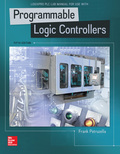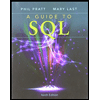
EBK LOGIXPRO PLC LAB MANUAL FOR PROGRAM
5th Edition
ISBN: 8220102803503
Author: Petruzella
Publisher: YUZU
expand_more
expand_more
format_list_bulleted
Concept explainers
Question
Chapter 15.6, Problem 3RQ
Program Plan Intro
Function block diagram (FBD):
- It is a graphical dataflow
programming process. - It allows program features which perform as blocks and they are wired similar to a circuit diagram.
- It is used in various applications that contain the flow of information or data between control element.
Expert Solution & Answer
Trending nowThis is a popular solution!

Students have asked these similar questions
using r language
I need help to solve a simple problem using Grover’s algorithm, where the solution is not necessarily known beforehand. The problem is a 2×2 binary sudoku with two rules:
• No column may contain the same value twice.
• No row may contain the same value twice.
Each square in the sudoku is assigned to a variable as follows:
We want to design a quantum circuit that outputs a valid solution to this sudoku. While using Grover’s algorithm for this task is not necessarily practical, the goal is to demonstrate how classical decision problems can be converted into oracles for Grover’s algorithm.
Turning the Problem into a Circuit
To solve this, an oracle needs to be created that helps identify valid solutions. The first step is to construct a classical function within a quantum circuit that checks whether a given state satisfies the sudoku rules.
Since we need to check both columns and rows, there are four conditions to verify:
v0 ≠ v1 # Check top row
v2 ≠ v3 # Check bottom row…
using r language
Chapter 15 Solutions
EBK LOGIXPRO PLC LAB MANUAL FOR PROGRAM
Ch. 15.1 - Prob. 1RQCh. 15.1 - Prob. 2RQCh. 15.1 - Prob. 3RQCh. 15.1 - Prob. 4RQCh. 15.1 - Prob. 5RQCh. 15.1 - Prob. 6RQCh. 15.1 - Prob. 7RQCh. 15.1 - Prob. 8RQCh. 15.1 - Prob. 9RQCh. 15.1 - Prob. 10RQ
Ch. 15.1 - Prob. 11RQCh. 15.1 - Compare the accessibility of program scope and...Ch. 15.1 - Prob. 13RQCh. 15.1 - What is the difference between a produced tag and...Ch. 15.1 - Prob. 15RQCh. 15.1 - State the data type used for each of the...Ch. 15.1 - Describe the make-up of a predefined structure.Ch. 15.1 - Describe the make-up of a module-defined...Ch. 15.1 - Describe the make-up of a user-defined structure.Ch. 15.1 - Prob. 20RQCh. 15.1 - Prob. 21RQCh. 15.1 - Prob. 22RQCh. 15.1 - Prob. 23RQCh. 15.2 - Prob. 1RQCh. 15.2 - Prob. 2RQCh. 15.2 - Prob. 3RQCh. 15.2 - Prob. 4RQCh. 15.2 - Prob. 5RQCh. 15.2 - Prob. 6RQCh. 15.2 - Prob. 7RQCh. 15.2 - Prob. 8RQCh. 15.2 - Prob. 9RQCh. 15.2 - Prob. 10RQCh. 15.2 - Prob. 11RQCh. 15.2 - Extend control of the original ControlLogix...Ch. 15.2 - Prob. 3PCh. 15.3 - Prob. 1RQCh. 15.3 - Prob. 2RQCh. 15.3 - Prob. 3RQCh. 15.3 - Prob. 4RQCh. 15.3 - Prob. 5RQCh. 15.3 - Prob. 6RQCh. 15.3 - Prob. 7RQCh. 15.3 - Prob. 8RQCh. 15.3 - Prob. 9RQCh. 15.3 - Prob. 10RQCh. 15.3 - Prob. 11RQCh. 15.3 - Prob. 12RQCh. 15.3 - Modify the original CLX ten-second TON timer...Ch. 15.3 - Prob. 2PCh. 15.3 - Prob. 3PCh. 15.3 - Prob. 4PCh. 15.3 - Prob. 5PCh. 15.3 - Prob. 6PCh. 15.4 - Prob. 1RQCh. 15.4 - Prob. 2RQCh. 15.4 - Prob. 3RQCh. 15.4 - Prob. 4RQCh. 15.4 - Prob. 5RQCh. 15.4 - Prob. 6RQCh. 15.4 - Prob. 7RQCh. 15.4 - Prob. 1PCh. 15.4 - Prob. 2PCh. 15.5 - Prob. 1RQCh. 15.5 - Prob. 2RQCh. 15.5 - Prob. 3RQCh. 15.5 - Prob. 4RQCh. 15.5 - Prob. 5RQCh. 15.5 - Construct a ControlLogix ladder rung with compare...Ch. 15.5 - Prob. 2PCh. 15.5 - A single pole switch is used in place of the two...Ch. 15.6 - Prob. 1RQCh. 15.6 - Name the four basic elements of an FBD.Ch. 15.6 - Prob. 3RQCh. 15.6 - Prob. 4RQCh. 15.6 - Prob. 5RQCh. 15.6 - Prob. 6RQCh. 15.6 - Prob. 7RQCh. 15.6 - Prob. 8RQCh. 15.6 - Prob. 9RQCh. 15.6 - Prob. 10RQCh. 15.6 - Prob. 11RQCh. 15.6 - How is a function block feedback loop created?Ch. 15.6 - Prob. 13RQCh. 15.6 - Prob. 14RQCh. 15.6 - Prob. 1PCh. 15.6 - Prob. 2PCh. 15.6 - Prob. 3PCh. 15.6 - Prob. 4PCh. 15.6 - Prob. 5P
Knowledge Booster
Learn more about
Need a deep-dive on the concept behind this application? Look no further. Learn more about this topic, computer-science and related others by exploring similar questions and additional content below.Similar questions
- I need help to solve a simple problem using Grover’s algorithm, where the solution is not necessarily known beforehand. The problem is a 2×2 binary sudoku with two rules: • No column may contain the same value twice. • No row may contain the same value twice. Each square in the sudoku is assigned to a variable as follows: We want to design a quantum circuit that outputs a valid solution to this sudoku. While using Grover’s algorithm for this task is not necessarily practical, the goal is to demonstrate how classical decision problems can be converted into oracles for Grover’s algorithm. Turning the Problem into a Circuit To solve this, an oracle needs to be created that helps identify valid solutions. The first step is to construct a classical function within a quantum circuit that checks whether a given state satisfies the sudoku rules. Since we need to check both columns and rows, there are four conditions to verify: v0 ≠ v1 # Check top row v2 ≠ v3 # Check bottom row…arrow_forward1 Vo V₁ V3 V₂ V₂ 2arrow_forward1 Vo V₁ V3 V₂ V₂ 2arrow_forward
- Preparing for a testarrow_forward1 Vo V₁ V3 V₂ V₂ 2arrow_forwardI need help to solve a simple problem using Grover’s algorithm, where the solution is not necessarily known beforehand. The problem is a 2×2 binary sudoku with two rules: • No column may contain the same value twice. • No row may contain the same value twice. Each square in the sudoku is assigned to a variable as follows: We want to design a quantum circuit that outputs a valid solution to this sudoku. While using Grover’s algorithm for this task is not necessarily practical, the goal is to demonstrate how classical decision problems can be converted into oracles for Grover’s algorithm. Turning the Problem into a Circuit To solve this, an oracle needs to be created that helps identify valid solutions. The first step is to construct a classical function within a quantum circuit that checks whether a given state satisfies the sudoku rules. Since we need to check both columns and rows, there are four conditions to verify: v0 ≠ v1 # Check top row v2 ≠ v3 # Check bottom row…arrow_forward
- I need help to solve a simple problem using Grover’s algorithm, where the solution is not necessarily known beforehand. The problem is a 2×2 binary sudoku with two rules: • No column may contain the same value twice. • No row may contain the same value twice. Each square in the sudoku is assigned to a variable as follows: We want to design a quantum circuit that outputs a valid solution to this sudoku. While using Grover’s algorithm for this task is not necessarily practical, the goal is to demonstrate how classical decision problems can be converted into oracles for Grover’s algorithm. Turning the Problem into a Circuit To solve this, an oracle needs to be created that helps identify valid solutions. The first step is to construct a classical function within a quantum circuit that checks whether a given state satisfies the sudoku rules. Since we need to check both columns and rows, there are four conditions to verify: v0 ≠ v1 # Check top row v2 ≠ v3 # Check bottom row…arrow_forwardI need help to solve a simple problem using Grover’s algorithm, where the solution is not necessarily known beforehand. The problem is a 2×2 binary sudoku with two rules: • No column may contain the same value twice. • No row may contain the same value twice. Each square in the sudoku is assigned to a variable as follows: We want to design a quantum circuit that outputs a valid solution to this sudoku. While using Grover’s algorithm for this task is not necessarily practical, the goal is to demonstrate how classical decision problems can be converted into oracles for Grover’s algorithm. Turning the Problem into a Circuit To solve this, an oracle needs to be created that helps identify valid solutions. The first step is to construct a classical function within a quantum circuit that checks whether a given state satisfies the sudoku rules. Since we need to check both columns and rows, there are four conditions to verify: v0 ≠ v1 # Check top row v2 ≠ v3 # Check bottom row…arrow_forwardDon't use ai to answer I will report you answerarrow_forward
- You can use Eclipse later for program verification after submission. 1. Create an abstract Animal class. Then, create a Cat class. Please implement all the methods and inheritance relations in the UML correctly: Animal name: String # Animal (name: String) + getName(): String + setName(name: String): void + toString(): String + makeSound(): void Cat breed : String age: int + Cat(name: String, breed: String, age: int) + getBreed(): String + getAge (): int + toString(): String + makeSound(): void 2. Create a public CatTest class with a main method. In the main method, create one Cat object and print the object using System.out.println(). Then, test makeSound() method. Your printing result must follow the example output: name: Coco, breed: Domestic short-haired, age: 3 Meow Meowarrow_forwardautomata theory can please wright the exact language it know for example say it knows strings start 0 and end with 1 this is as example also as regular expressionarrow_forwardI would like help to resolve the following case, thank youarrow_forward
arrow_back_ios
SEE MORE QUESTIONS
arrow_forward_ios
Recommended textbooks for you
 C++ Programming: From Problem Analysis to Program...Computer ScienceISBN:9781337102087Author:D. S. MalikPublisher:Cengage Learning
C++ Programming: From Problem Analysis to Program...Computer ScienceISBN:9781337102087Author:D. S. MalikPublisher:Cengage Learning C++ for Engineers and ScientistsComputer ScienceISBN:9781133187844Author:Bronson, Gary J.Publisher:Course Technology Ptr
C++ for Engineers and ScientistsComputer ScienceISBN:9781133187844Author:Bronson, Gary J.Publisher:Course Technology Ptr Systems ArchitectureComputer ScienceISBN:9781305080195Author:Stephen D. BurdPublisher:Cengage Learning
Systems ArchitectureComputer ScienceISBN:9781305080195Author:Stephen D. BurdPublisher:Cengage Learning EBK JAVA PROGRAMMINGComputer ScienceISBN:9781337671385Author:FARRELLPublisher:CENGAGE LEARNING - CONSIGNMENT
EBK JAVA PROGRAMMINGComputer ScienceISBN:9781337671385Author:FARRELLPublisher:CENGAGE LEARNING - CONSIGNMENT A Guide to SQLComputer ScienceISBN:9781111527273Author:Philip J. PrattPublisher:Course Technology Ptr
A Guide to SQLComputer ScienceISBN:9781111527273Author:Philip J. PrattPublisher:Course Technology Ptr

C++ Programming: From Problem Analysis to Program...
Computer Science
ISBN:9781337102087
Author:D. S. Malik
Publisher:Cengage Learning


C++ for Engineers and Scientists
Computer Science
ISBN:9781133187844
Author:Bronson, Gary J.
Publisher:Course Technology Ptr

Systems Architecture
Computer Science
ISBN:9781305080195
Author:Stephen D. Burd
Publisher:Cengage Learning

EBK JAVA PROGRAMMING
Computer Science
ISBN:9781337671385
Author:FARRELL
Publisher:CENGAGE LEARNING - CONSIGNMENT

A Guide to SQL
Computer Science
ISBN:9781111527273
Author:Philip J. Pratt
Publisher:Course Technology Ptr